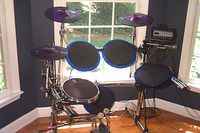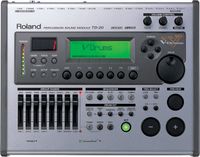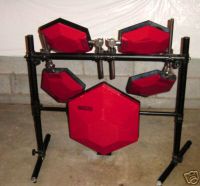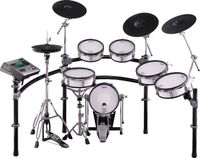 Basic electronic drum set.
Basic electronic drum set.An electronic drum is a percussion instrument in which the sound is generated by an electronic waveform generator or sampler instead of by acoustic vibration.
Contents |
How Electronic Drums Work
 Roland Module
Roland Module
When an electronic drum pad is struck, a voltage change is triggered in the embedded piezoelectric transducer (piezo) or force sensitive resistor (FSR). The resultant signals are transmitted to an electronic drum module via TS or TRS cables, and are translated into digital waveforms, which produce the desired percussion sound assigned to that particular trigger pad. Most newer drum modules have trigger inputs for 2 or more cymbals, a kick, 3-4 toms, a dual-zone snare, (head and rim) and a hi-hat. The hi-hat has a foot controller which produces open and closed sounds with some models offering variations in-between. By having the ability to assign different sounds to any given pad, the electronic drummer has nearly unlimited potential for configuring many different sounding drum kits from one set of electronic drums. Additionally, electronic drummers can sample non-percussive sounds and use them as drum sounds, as is the case with most industrial music. Many see this as a great advantage over acoustic drums, as one can have a jazz, rock or ballad drumset by merely changing the kit selector switch on the module.
Early Electronic Drums
 Early Simmons Kit
Early Simmons Kit
Many drummers claim that early electronic drums gave only an approximation of the sound of acoustic drums, as there were often technical issues with triggering, as well as musical issues such as decreased range of dynamic and tonal subtlety. Consequently, the pioneering electronic drumsets such as the early Simmons and Yamaha models, were often used for certain types of rock, disco and techno genres in which the drums were usually expected to play a specific pattern or beat repeatedly with no variation in timbre. These were little more than manual sequencers.
It should be noted that there are inexpensive low-end drums and modules currently in production whose quality is just marginally better than their pioneering counterparts. For the most part, these are targeted toward the hobbyist or novice drummer.
Recent Innovations
 Roland TD-20
Roland TD-20
Newer drum kits by Roland, Ddrum and Yamaha have addressed many of the downfalls of early electronic drums. While each of these manufacturers have entry-level units, the professional kits are geared toward creating a sound and playing experience which is nearly indistinguishable from a quality acoustic kit. Examples include the Yamaha DTXtreme IIS, the DDrum4SE and Roland's TD-12 and TD-20, having 2006 MSRPs ranging between $2,195.00 and $6,699.00. [1] Typically, these high-end kits are equipped with:
- High quality digital samples- These modules offer 24 bit samples of actual percussion sounds with hundreds of samples from which to choose.
- Positional sensing and dynamic impact detection- The module can detect which area of the drum head is impacted, and provide a sample representative of that strike on an acoustic head. Additionally, the volume and timbre of the strike is dependent on the strength of the impact.
- Multiple triggers- Snares and Toms have impact zones for both the head and the rim, allowing for rim and cross shots as well as shell tapping. Cymbals can accommodate zones for edge, bow and bell strikes.
- Realistic Hi-Hats- These are mounted on standard stands, and allow for actual open and closed foot playing. An electronic module within the unit detects the movement and provides variations of open, partially open, and closed samples as played, with different sounds assigned to a foot close, and a quick close-open.
- Multiple outputs- These modules have multiple 'outs' to the sound board such that each percussion group (ie. Toms, Cymbals, etc) can be independently mixed (like the multiple miking of an acoustic kit). Additionally, these groups have independent volume faders on the module to fine tune volume settings for each group.
- Expansion slots/MIDI connections- for upgrading samples and software as they are improved through continuing R&D efforts.
Though these innovations may help attract serious drummers, many purists feel that electronic drum kits will never offer the same nuances and playability of an acoustic set.
Electronic Drumming Communities
The following are links to community sites: forums, mailing lists, etc... related to electronic drumming:
By Brand
- The Simmons House A fan site for Simmons electronic percussion made by Destin LeCornu.
- V-Drums.com : Unofficial Roland V-Drum site
- Roland Drum Machines on Yahoo Groups
- Simmons Drums on Yahoo Groups
- Yamaha DTXpress Electronic Drums on Yahoo Groups
- eDrumming.com : electronic percussion forum.
By Topic
- DrumLinks.com: Numerous links to electronic drums-related sites.
- eDrumming.com : electronic percussion forum.
- The Electronic Drums Group on Yahoo Groups
- ElectroDrums on Yahoo Groups
- Drum Triggers DIY : Create an electronic drum kit yourself.
Manufacturers of electronic drums and drum triggers
Listed below are some of the companies that produce electronic drum modules, trigger pads, and acoustic triggers
- Alesis
- Alternate Mode
- Boom Theory
- Dauz
- Ddrum
- Hart Dynamics
- Mandala Drums
- Pacific Digital Corporation
- Pintech
- RET Percussion
- Roland Corporation
- Sherpa
- Smartrigger
- Staff Drum
- Yamaha Corporation
Famous drummers that use electronic drums, or have used them in the past
- Danny_Carey (Tool) - several Mandala and Simmons drums
- Nick_Mason (Pink_Floyd)
- Akira_Jimbo
Categories: Electronic music instruments | Drums | Drum machines | Percussion instruments




 216.73.216.190
216.73.216.190 User Stats:
User Stats:
 Today: 0
Today: 0 Yesterday: 0
Yesterday: 0 This Month: 0
This Month: 0 This Year: 0
This Year: 0 Total Users: 117
Total Users: 117 New Members:
New Members:
 147.135.xxx.xxx
147.135.xxx.xxx
 Server Time:
Server Time: